XRP Price Prediction: Is the $50 Target Achievable?
XRP Recent Price Review

Source: https://www.gate.com/trade/XRP_USDT
As of July 22, 2025, XRP closed at $3.4958, with a high of $3.5734 and a low of $3.4665. The 24-hour trading volume was approximately $760.07 million. Since the start of January 2025, when XRP traded at $1.20, the token has increased by over 190%. Over the past six months, XRP has fluctuated between $3.00 and $4.00, with upward momentum driven by significant whale accumulation.
Market Drivers and Technical Signals
1. Ripple Infrastructure Developments
- In May 2025, Ripple announced completion of a pilot for cross-border payments with Japan’s Mitsubishi UFJ Bank.
- By mid-July, Ripple entered a strategic partnership with MercadoPago—the largest payments platform in South America—to meet growing global liquidity needs.
2. Technical Bullish Indicators
- The 20-day and 50-day SMAs formed a golden cross, a classic bullish momentum signal indicating strengthened mid-term upside.
- The 14-day RSI is near 60, indicating it is not yet overbought and suggesting further room for gains.
- Trading volumes have increased alongside price gains, indicating sustained buying pressure.
3. On-Chain and Derivatives Data
- Glassnode data shows that over the past 30 days, the number of XRP whale addresses (holding at least 1 million XRP) increased by 12%.
- Traders have kept open interest in perpetual contracts on OKX and Binance elevated for four consecutive weeks, with leveraged capital predominantly long.
Rationale Behind the $50 Target
For XRP to rise from roughly $3.50 to $50, its market cap would need to jump from about $20 billion to $280 billion. With circulating supply unchanged, this would represent a nearly 14-fold price increase. Achieving this would require:
- Integration with global mainstream payment networks: For example, if over 50 major international banks used XRP for cross-border settlement, with daily settlement volumes exceeding $10 billion.
- Institutional allocation at scale: Leading hedge funds and asset managers include XRP in their primary digital asset exposure.
- Complete resolution of legal risks: If Ripple and the SEC reach a settlement in 2025 and the regulatory framework is revised so XRP is classified as a utility token rather than a security.
- Surging demand for macro hedges: In the event of massive global currency devaluation or runaway inflation, XRP could attract capital as a “digital gold.”
- Ecosystem innovation and stablecoin issuance: For example, Ripple could launch various stablecoin solutions pegged to XRP, which would boost on exchange and off exchange liquidity.
Market and Industry Comparisons
- Compared to BTC and ETH: Bitcoin’s market cap is currently about $1.6 trillion, while Ethereum’s is around $500 billion. XRP would need to match Ethereum’s market cap to reach $280 billion.
- Compared to other cross-border payment projects: Stellar (XLM) has a market cap of about $15 billion. SWIFT GPI remains un-tokenized. If XRP leads this segment, it retains a key first-mover advantage.
Primary Risk Factors
- Regulatory uncertainty: If the SEC imposes new regulatory actions on Ripple, or if the EU enacts stricter digital asset rules, XRP could face heavy fines or trading restrictions.
- Intense competition: Central Bank Digital Currencies (CBDCs) and cross-chain bridge technologies from blockchains such as Ethereum and Cosmos could divert users from XRP’s cross-border payments niche.
- Market sentiment swings: If macroeconomic conditions improve and risk appetite shifts back to traditional assets, digital assets as a whole could face headwinds.
- Technical implementation challenges: XRP Ledger must balance throughput (TPS) and distributed node security. Before large-scale commercial adoption, the network may experience congestion or security risks.
Investment Guidance and Position Management
1. Phased Entry:
- First tier: Accumulate 40% in the $3.40–$3.35 zone over several purchases;
- Second tier: Buy an additional 30% in the $3.30–$3.20 range;
- Third tier: Allocate the final 30% after the price bottom is confirmed.
2. Dynamic Take-Profit and Stop-Loss:
- Set take-profit targets at $5, $10, $20, $30, and $50, which are critical psychological milestones;
- If the price falls below $3.20, investors should cut losses and exit decisively.
3. Position sizing: Limit exposure to any single crypto asset to 5%–10% of your portfolio to avoid overconcentration.
4. Ongoing monitoring: Monitor updates on Ripple’s partnerships, SEC litigation, and on-chain whale positions closely.





